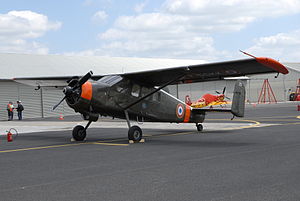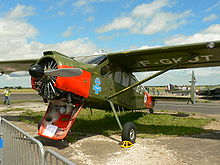- Max Holste Broussard
-
Broussard Role Six-seat utility monoplane National origin France Manufacturer Avions Max Holste First flight 1952 Introduction 1954 Retired 1983 Primary user French Army Number built 396 Developed from Max Holste MH.152 The Max Holste MH.1521 Broussard is a 1950s French six-seat utility monoplane designed by Max Holste to meet a French Army requirement.
Design and development
The MH.1521 Broussard was designed to meet a requirement for a lightweight liaison and observation aircraft. It is a braced high-wing monoplane with twin vertical tail surfaces. It has a fixed tailwheel landing gear and is powered by a nose-mounted Pratt & Whitney R-985 radial piston engine.
A smaller 220 hp (164 kW) Salmson Argus powered prototype aircraft, the MH.152, was first flown on 12 June 1951; it had room for a pilot and four passengers but was too small and underpowered to meet the Army requirement. The company decided to develop a slightly larger version and changed the engine to a Pratt and Whitney Wasp Junior, which at 450 hp provided almost twice as much power. This model was designated the MH.1521 and later named the Broussard (lit. Man of the Bush, in the context of Bush Pilots rather than Bushmen). Its development was enthusiastically supported at a political level by WWII fighter ace and French war hero Pierre Clostermann, a close friend of Max Holste. Clostermann wrote a faction (literature) novel, "Leo 25 Airborne", based on his experiences flying Broussards with Escadrille ELO 3/45 in Algeria.
The prototype Broussard first flew on the 17 November 1952 and was followed by the first civil and military production aircraft in June 1954, and 363 were built between 1954 and 1959. Its similarity to the de Havilland Canada DHC-2 Beaver in looks, capability and performance lead it to be nicknamed "the French Beaver".
Operational history
It saw service in the Algerian War of Independence as an Army cooperation aircraft, mostly as an artillery spotter and in an air supply/ambulance role where its good short-field performance and resistance to ground fire were required. Its distinctive sound, made by its noisy radial engine and large propeller, was a disadvantage as the Algerian guerrillas could hear its approach long before other aircraft. It remained in service until the 1980s, and can still be seen in France, the UK, and the U.S. of A. being operated by enthusiasts or collectors.
Variants
- MH.1521
- Protoypes, five built plus two pre-production aircraft and 19 pre-production military variants.
- MH.1521A
- Aircraft modified for agricultural use.
- MH.1521C
- Commercial variant, 52 built.
- MH.1521M
- Military variant, 318 built.
- MH.1522
- One modified prototype aircraft flown in 1958 with full span leading-edge slots and double-slotted trailing edge flaps to improve stall performance.
Operators
- Benin Air Force
- Cameroun Air Force
- Central African Air Force
- Ivory Coast Air Force
- Malagasy Air Force
- Mauritanian Islamic Air Force
- Niger Air Force
- Senegal Air Force
Survivors
Broussard G-YYYY flies from Eggesford, UK in 2010.
Specifications (MH.1521M)
Data from [1]
General characteristics
- Crew: 1
- Capacity: 5
- Length: 8.65 m (28 ft 4½ in)
- Wingspan: 13.75 m (45 ft 1¼ in)
- Height: 3.65 m (12 ft 0 in)
- Wing area: 25.20 m2 (271.26 ft2)
- Empty weight: 1530 kg (3373 lb)
- Gross weight: 2500 kg (5512 lb)
- Powerplant: 1 × Pratt & Whitney R-985-AN-1 radial piston engine, 336 kW (450 hp)
Performance
- Maximum speed: 270 km/h (168 mph)
- Service ceiling: 5500 m (18045 ft)
See also
- Aircraft of comparable role, configuration and era
- De Havilland Canada Beaver
References
- Notes
- ^ Orbis 1985, pp 2436
- Bibliography
- Taylor, Michael J. H. (1989). Jane's Encyclopedia of Aviation. London: Studio Editions.
- The Illustrated Encyclopedia of Aircraft (Part Work 1982-1985). Orbis Publishing. pp. 2436.
- Simpson, R.W.. Airlife's General Aviation. England: Airlife Publishing. pp. 176. ISBN 1 85310 104 X.
Lists relating to aviation General Aircraft (manufacturers) · Aircraft engines (manufacturers) · Airlines (defunct) · Airports · Civil authorities · Museums · Registration prefixes · Rotorcraft (manufacturers) · TimelineMilitary Accidents/incidents Records Categories:- French military utility aircraft 1950–1959
- Max Holste aircraft
Wikimedia Foundation. 2010.


